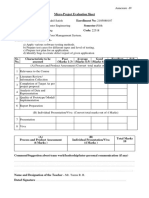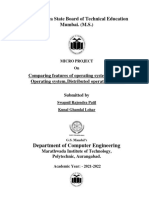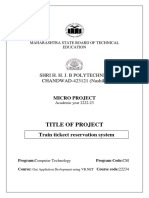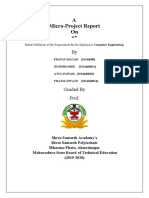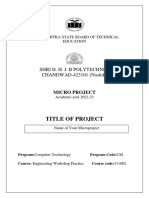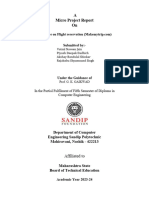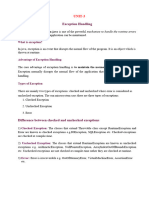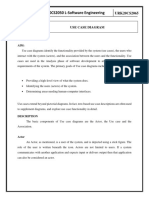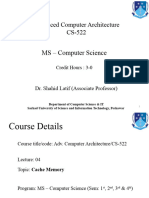Teacher Evaluation Sheet
Name of Student: Borse Shubham Dattu
Enrolment No:2200790197
Name of Program: Computer Technology Semester:-V
Course Title: Software Testing (STE) Code: -22518
Title of the Micro Project: Airline Reservation system .
Course Outcomes Achieved:-
a) CO-a. Apply various software testing methods.
b) CO-b. Prepare test cases for different types and levels of testing.
c) CO-c. Prepare test plan for an application.
d) CO-d. Identify bugs to create defect report of given application.
Evaluation as per Suggested Rubric for Assessment of Micro-Project:
Sr.
No. Characteristic to be Poor (Marks Average Good Excellent (Marks
assessed 1-3) (Marks 4-5) (Marks 6 - 8) 9-10)
(A) Process and Product Assesssment (Convert above total marks out of 6 marks)
1 Relevance to the Course
Literature Survey /
2
Information Collection
Completion of the Target as
3
per project proposal
Analysis of data and
4
representation
5 Quality of Prototype / Model
6 Report Preparation
(B) Individual Presentation / Viva (Convert above total marks out of 4 marks)
8 Presentation
9 Viva
Micro – Project Evaluation Sheet:
Process Assessment Product Assessment
Part Part
Project Individual Total
A– B – Project
Methodology Presentation / Marks
project Report /
Name of Student (2 marks) Viva(4 marks) 10
Proposal Working
(2 marks Model(2 marks)
Borse Shubham Dattu
Comments / Suggestions about team work / leadership / inter – personal communication (if any) Any
Other Comment
Name & designation of the faculty memberMr. G. M. Lodha Signature
1
� MAHARASHTRA STATE BOARD OF
TECHNICAL EDUCATION
SNJBs SHRI H. H. J. B.
POLYTECHNIC, CHANDWAD-423101
(Nashik)
MICRO PROJECT
Academic year: 2024-25
TITLE OF PROJECT
Airline Reservation System
Program:Computer Technology Program Code:CM
Course: Software Testing Course code: 22518
2
�MAHARASHTRA STATE BOARD OF TECHNICAL EDUCATION
CERTIFICATE
This is to certify Borse Shubham Dattu of 5th Semester of Diploma in Computer Technology
of Institute, Shri H.H.J.B. Polytechnic, Chandwad (Code: 0079) has completed the Micro-
Project satisfactorily in Subject Software Testing (22518) for the academic year 2023-2024
as prescribed in the curriculum.
Place: CHANDWAD
Date: / /2023
Course Teacher Head of the Department Principal
(Mr. G. M.. Lodha) (Mr. P. R. Sali) (Dr. V. A. Wankhede)
Seal of
Institute
3
� INDEX
SR_N PAGE
CONTENT
O. NO.
Part A
1 Brief Introduction 5
2 Aim of Micro Project 5
3 Action Plan 5
4 Resources Required 5
Part B
1 Brief Description 6
2 Aim of Micro Project 6
3 Course Outcome Integrated 6
4 Actual Resource Used 6
5 Applications of Microproject 6
4
� PART A-Plan
Title of micro-project: Airline Reservation System
1. Aim/Benefits of the Micro-Project-
a) Finding the defects which may get created by the
programmer while developing the software.
b) Find out defect and issue
c) To prevent defect
2. Course Outcomes Addressed-
d) CO-a. Apply various software testing methods
e) CO-b. Prepare test cases for different types and levels of testing
f) CO-c. Prepare test plan for an application
g) CO-d. Identify bugs to create defect report of given application
3. Proposed Methodology-
Here we test the software for different types and levels of testing.We try
to prepare test plan and test cases and find out the error in software.
4. Action Plan-
Planned Start Planned Finish
Sr no. Details of activity
Date Date
1. Finalization of topic
2. Preparation of Abstract
3. Collection of data
4. Preparation of concept
5. Seminar / Presentation
6. Submission of Micro Project
5. Resources Required:
Sr.No Name of Specification Quantity Remarks
Resource/Material
1. Computer i3,RAM 2GB
1
(Desktop/Laptop)
2. Microsoft office word 2010 1
3. Books
4. Websites
5. Softwares Notepad, Web
1
Browser
5
� PART B-Plan
Title of micro-project: Airline Reservation System
1. Brief Description:
The Airline reservation system facilitates the passengers to enquiry about
the trains available on the basis of source and destination, booking and
cancellation of tickets, enquiry about the status of the booked ticket, etc.
2. Aims/Benefits of Micro Project:
The aim of case study is to design and develop a data base maintaining
records of different trains, train status and passengers.This project
contains introduction to the railways reservation system.
3. Course Outcomes Achieved:
CO-a. Apply various software testing methods
CO-b. Prepare test cases for different types and levels of
testing CO-c. Prepare test plan for an application
CO-d. Identify bugs to create defect report of given application
4. Actual Resources Used:
Sr.No Name of Specification Quantity Remarks
Resource/Material
1. Computer i5,RAM 8GB 1
(Desktop/Laptop)
2. Microsoft office word 2010 1
3. Books
4. Websites
5. Softwares 1
5. Applications of Microproject:
Requirements Analysis
Test Planning
Test Data Preparation
6
� TABLE OF CONTENTS
Contents
1 Introduction
2 Abtract
4 Design view
5 Test Plan
6 Test Cases
7 Test Cases for login form
8 Test Cases for main form
9 Test Summary report
10 Defect report
11 Defect management of our micro project
12 Conclusion & Future Scope
13 References
7
� 1. INTRODUCTION
A Airline reservation system is a crucial component of modern Airline
management, designed to efficiently manage and streamline the process of
booking train tickets for passengers. It plays a pivotal role in ensuring the
smooth functioning of a country's Airline network by offering convenience to
travelers, optimizing seat allocation, and enhancing overall
operational efficiency
2. ABSTRACT
The Airline reservation system facilitates the passengers to enquiry about the
trains available on the basis of source and destination, booking and
cancellation of tickets, enquiry about the status of the booked ticket, etc. The
aim of case study is to design and develop a data base maintaining records of
different
trains, train status and passengers.This project contains introduction to the
railways reservation system. It is the computerized system of reserving the seats
of train seats in advance. It is mainly used for a long route. Online reservation
has made the process for the reservation of seats very much easier
than ever before.
8
� 4. TEST PLAN
Testing Methodologies:
A strategy for software testing must accommodate low-level tests that are
necessary to verify that a small source code segment has been correctly
implemented as well as high-level tests that validate major system functions
against customer requirements. A strategy must provide guidance for the
practitioner and a set of milestones for the manager. Because the steps of the test
strategy occur at a time when deadline pressure begins to rise, progress must be
measurable and problems must surface as early as possible. Following testing
techniques are well known and the same strategy is adopted during this project
testing.
• Unit testing:
Unit testing focuses verification effort on the smallest unit of software design
the software component or module. The unit test is white-box oriented. The unit
testing implemented in every module of Airline Reservation System. by giving
correct manual input to the system, the data are stored in database and
retrieved. If you want required module to access input or get the output from
the End user. any error will accrue the time will provide handler to show what
type of error will occrued.
• System testing:
System testing is actually a series of different tests whose primary purpose is to
fully exercise the computer-based system. Below we have described the two
types of testing which have been taken for this project. it is to check all modules
worked on input basis. if you want change any values or inputs will change all
information. so specified input is must.
• Performance Testing:
Performance testing is designed to test the run-time performance of software
within the context of an integrated system. Performance testing occurs
throughout all steps in the testing process. Even at the unit level, the
performance of an individual module may be assessed as white-box tests are
conducted. This project reduce attendance table, codes. it will generate report
fast.no have extra time or waiting of results .
9
� 5. TEST CASES
Test case is an object for execution for other modules in the architecture does
not represent any interaction by itself. A test case is a set of sequential steps to
execute a test operating on a set of predefined inputs to produce certain
expected outputs. There are two types of test cases: manual and automated. A
manual test case is executed manually while an automated test case is executed
using automation. In system testing, test data should cover the possible values
of each parameter based on the requirements. Since testing every value is
impractical, a few values should be chosen from each equivalence class. An
equivalence class is a set of values that should all be treated the same. Ideally,
test cases that check error conditions are written separately from the functional
test cases and should have steps to verify the error messages and logs.
Realistically, if functional test cases are not yet written, it is ok for testers to
check for error conditions when performing normal functional test cases. It
should be clear which test data, if any is expected to trigger errors.
6. TEST CASES FOR LOGIN FORM
Sr.no Test Case Expected Actual Test Result
Result Result
1 Enter valid name and Software The error Unsuccessful
the password & click on should display message is
login button display
2 Enter Invalid Software As Successful
should not expected,
display main the error
window message is
display
10
� 8. TEST CASES FOR MAIN FORM
Sr.no Test Case Input steps Expected Result Actual Result Test Result
1 User login 1. open the The login screen Login screen Successful
application should be displayed display
2. enter valid
username
and password
3. click
login button
2 Invalid 1. enter invalid The login screen Login screen Successful
login username and should be displayed display
attempt password
3 Search for 1. Login and The search screen Search screen Successful
trains access main should be displayed. display
form.
2. enter source
and destination
date and other
relevant info.
Book a 1. search for train. System should Booking screen Successful
4 ticket 2. select a train confirm the booking displayed
from list.
3. enter passenger
details.
4. click the book
button
5 Cancel 1. access the The system should Cancellation Successful
booking booking history. cancel the booking screen displayed
2. select a
booking to
cancel
11
� 10. TEST SUMMARY REPORT
Test Total No. No. of Test Defect/ No. Of Approval Aproved
Case Of Test cases Devlation/ Tests Time/Date by
Identifier cases reexecuted Problem (if
executed any) Pass Fail
1. 5 1 No Pass 10/11/2024 Borse
Shubha
m
2. 8 2 Login Fail 10/11/2024 Borse
shubha
m
3. 10 5 No Pass 10/11/2024 Borse
shubha
m
4. 2 0 No Pass 10/11/2024 Borse
shubha
m
11. DEFECT REPORT
ID Df_011
Project Login Project
name
Product Airline Reservation System
name
Release 1.12.1
Version
Module Login
Detected 1.12.0
build
version
Summary The defect is found at a login form, where the user input the word
instead of numeric ID
12
� 12. DEFECT REPORT MANAGEMENT
Description The defect is found at a login form, where the user input the word
instead of numeric ID. As expected, it doesn’t give any message if
user inserted the word instead of the numeric ID. It must need to
give the proper feedback or message to the user for this mistake.
Steps to 1. Enter the word
replicate 2. Then password
3. Then click on the login
Actual result The error message is not given
Expected It must need to give the error message for defect mistake
result
Attachments --
Remarks --
Severity Medium
Priority Low
Reported by
Assigned to
Status Almost solve
Fixed build 1.13.5
version
13
� 13. CONCLUSION
a Airline reservation system is a critical component of modern rail transportation
management. It serves as the backbone for passenger ticketing and seat
allocation processes, ensuring a seamless and efficient travel experience. Here
are the key points to summarize the importance and role of a Airline reservation
system:
Efficiency: Airline reservation systems streamline the booking process, reducing
the time passengers spend in queues and providing convenient online booking
options.
Convenience: Passengers can book tickets from anywhere, anytime, using online
platforms or mobile applications, making it highly convenient and accessible.
Transparency: Real-time information on train schedules, seat availability, and
ticket status is readily accessible, improving the overall travel experience for
passengers.
Revenue Generation: Airline reservation systems help optimize revenue through
efficient seat allocation, dynamic pricing strategies, and data-driven decision-
making.
Security: Robust security measures are in place to protect passenger data and
online transactions, ensuring the safety and trustworthiness of the system.
14. . REFRENCES
Website –
• www.w3schools.com
• https://www.geeksforgeeks.org/
• www.tutorialspoint.com
• https://www.freeprojectz.com/
14




